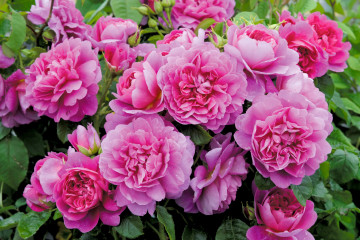Rose Swany - description and characteristics of the variety
Content:
Rose Swanee is one of the most spectacular ground cover crops. The plant spreads beautifully on the ground and covers a large area. Therefore, it is often called carpet. To succeed in growing a crop, you need to provide it with proper care.
Rose Swany (Swanee, Swanee, MEIburenac) - what is this variety
The culture was derived from the Japanese wrinkled rose.
For the first time a varietal rose was obtained in 1977 in France.
- In 2003, Meilland breeders introduced a new variety - Pink Swany. This culture is characterized by a change in the color of the inflorescences from pale pink to lilac. They have a pronounced pleasant aroma and look very impressive.
- Then another revision of the Swanee ground cover rose was received - Ed. Bright red inflorescences have become a characteristic feature of the culture.
Roses of this variety are characterized by lush, branchy bushes with a lot of leaves. They reach 60-70 cm in height, and 2 m in diameter. The foliage is small and rich in green color.
Terry inflorescences reach 5-6 cm in diameter. Flowers are white with a pink tint in the center. They form umbellate inflorescences, each of which can contain up to 20 buds.
Advantages and disadvantages of the variety
The advantages of culture include the following:
- excellent decorative properties;
- long and abundant flowering;
- delicate pleasant aroma;
- frost resistance;
- strong immunity.
At the same time, the culture has some disadvantages.
Despite its resistance to frost, the Swanee rose still needs preparation for winter. She also requires quality care.
Use in landscape design
Swany ground cover rose looks great in flowerpots and containers. It can also be planted on slopes. Thanks to this, it is possible to compact the top layer of the soil and protect it from erosion.
The plant is great for single plantings and the formation of spectacular compositions. To emphasize the decorativeness of the culture, you can use dark green bushes.
Growing a flower, how to plant it in open ground
To succeed in growing a crop, you need to study its description and carry out planting work correctly.
This crop is not propagated by seed. It is best to use ready-made seedlings for planting. In mild climates, it is permissible to use cuttings.
In regions with mild winters, the crop can be planted in the fall - from mid-September to mid-October. Thanks to this, roses will be able to adapt to new conditions before the onset of cold weather. If severe frosts are expected, planting work should be carried out in the spring.
Location selection
It is recommended to choose a well-lit area for culture. Occasionally a shadow may appear. Roses should be placed in the west or southeast.
Loam is considered the ideal option for culture.
The soil should be neutral or slightly acidic. High-quality drainage and aeration are of great importance.
How to prepare the soil and flower for planting
1 year before planting, it is worth adding nitrogen or organic fertilizers to the soil. If the soil is clayey or marshy, sand should be added to the bottom of the depression.
Light sandy soil requires the use of a 10 cm layer of clay. To facilitate the rooting process, the soil in the depression must be well loosened.
Before carrying out planting work, it is worth carefully examining the state of the root system in order to identify damaged areas. They must be removed and the cuts must be sprinkled with crushed coal.
Planting procedure step by step
To plant a crop, you must do the following:
- Spread out the roots of the seedling. The kidneys below the inoculation area must be removed.
- Trim the roots and dip in the clay solution.
- Pour a layer of sand 10 cm thick at the bottom of the recess. This option is suitable for clay soil. For too loose soil, it is better to use clay.
- Pour in 2 buckets of compost and make a small hill.
- Place the seedling in the recess. The grafting area should be located just below the ground.
- Slightly compact the soil.
- Drizzle and cover with humus or compost.
Plant care
In order for the Swanee rose, as it is sometimes called, to grow and develop normally, it needs full and high-quality care.
Watering rules and humidity
Watering the plant is necessary in the morning or evening. Otherwise, the foliage may burn.
In the first year, the rose is moistened twice a week. Then this can be done every 7-10 days. The irrigation regime is influenced by weather conditions.
Top dressing and soil quality
During the growing season, the crop must be fed three times per season. The first 2 times, complex mineral preparations are used. The last feeding involves the use of phosphorus and potassium.
Pruning and replanting
It is recommended to prune the crop in the spring. During this period, it is worth removing frost-affected branches and dry shoots. In the fall, it is necessary to carry out sanitary pruning of the crop. In this case, you need to get rid of weakened and sick shoots. Once every 5 years, it is worth rejuvenating the bush.
Transplanting an adult plant is not recommended. If such a need nevertheless arises, the procedure is carried out by transshipment.
Features of wintering a flower
Although the plant is considered frost-resistant, it must be covered for the winter. This is especially important for young cultures. You can insulate the bushes with fallen leaves or spruce branches. It is also permissible to use a special covering material.
In the spring, the bushes should be opened in a timely manner so that they do not spoil.
Blooming rose
The culture is distinguished by its wonderful lush flowering. Snow-white inflorescences go well with green foliage. The culture can be grafted onto the stem. With proper care, you can get an excellent standard plant.
The bushes begin to bloom in June and retain their decorative effect until mid-autumn. Then the Swanee rose has a dormant period.
During the flowering period, fertilizers based on potassium and phosphorus are applied under the bushes. It is also worth removing wilted buds in time - this stimulates the appearance of new flowers.
What to do if it does not bloom, possible reasons
The lack of flowering is due to insufficient care. Most often, the problem appears when the wrong place for the flower is chosen. It is important that the site is well lit.
Also, the lack of flowers can be associated with a large amount of green mass. This is most often due to excess nitrogen in the soil.
The buds may be missing even after a difficult winter.
In such a situation, the plant needs a full recovery after the cold weather. Another factor is the development of diseases or the defeat of the culture by parasites.
Flower propagation
Most often, the rose is propagated by cuttings or using cuttings. There is no point in using the seed method. This crop belongs to hybrid varieties. Therefore, this method of growing will not help preserve the features of the mother plant.
It is necessary to propagate the plant in the fall. During this period, planting material should be prepared.
The rose can be propagated by layering. To do this, take a shoot, press it to the ground and wait for rooting. Later, it must be sprinkled with soil and watered well.
When breeding a culture by cuttings, it is worth taking ripe shoots with 3 internodes and making a cut under the lower bud. Soak the culture in a growth promoter for 2 hours and plant in a shaded place.
In this case, you need to make small indentations of 15 cm in size. Place the plants in the holes and sprinkle with soil. Compact and water the soil.
Diseases, pests and ways to control them
If the rules of care are violated, the plant may encounter diseases and pests. Most often, the rose suffers from such parasites:
- Spider mite. This insect often attacks plants. Actellik or Fitoverm help to cope with parasites.
- Rose sawfly. The caterpillars of these parasites eat the leaves. To deal with pests, the affected stems must be removed. In this case, the plants are treated with Aktellik or Iskra.
- Aphid. Most often, insects reproduce when there is an excess amount of nitrogen in the soil. Fitoverm, Karbofos help to cope with parasites.
Also, the rose can suffer from the following diseases:
- Gray rot. With the development of pathology, rotting of all fragments of the culture is observed. Copper chloroxide helps to cope with it.
- Rust. The disease appears on the leaves when attacked by aphids and worms. Copper sulfate helps to cope with the disease.
- Powdery mildew. In this case, the leaves are covered with a gray bloom. An infusion of ash or mullein will help to cope with the disease.
The Swanee rose is an excellent ornamental plant that is actively used in landscape design. To succeed in growing a crop, you need to properly care for it.




















